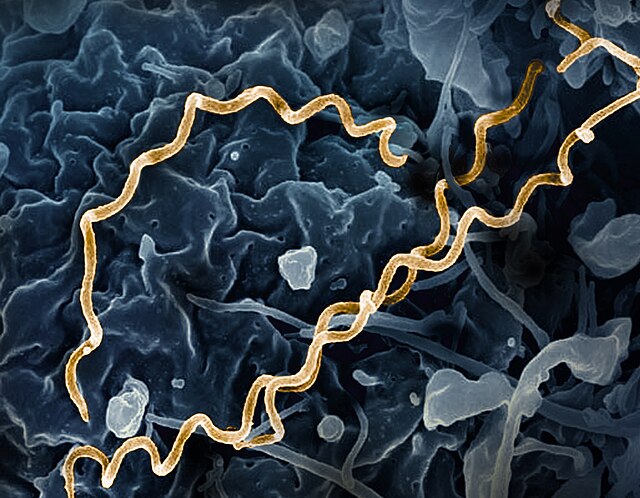Treponema pallidum, formerly known as Spirochaeta pallida, is a microaerophilic spirochaete bacterium with subspecies that cause the diseases syphilis, bejel, and yaws. It is transmitted only among humans. It is a helically coiled microorganism usually 6–15 μm long and 0.1–0.2 μm wide. T. pallidum's lack of either a tricarboxylic acid cycle or oxidative phosphorylation results in minimal metabolic activity. The treponemes have a cytoplasmic and an outer membrane. Using light microscopy, treponemes are visible only by using dark-field illumination. T. pallidum consists of three subspecies, T. p. pallidum, T. p. endemicum, and T. p. pertenue, each of which has a distinct associated disease.
Treponema pallidum
Electron micrograph image of T. pallidum, highlighted in gold.
A spirochaete or spirochete is a member of the phylum Spirochaetota, which contains distinctive diderm (double-membrane) Gram-negative bacteria, most of which have long, helically coiled cells. Spirochaetes are chemoheterotrophic in nature, with lengths between 3 and 500 μm and diameters around 0.09 to at least 3 μm.
Spirochaete
Endoflagella Components. Legend: Fig. 1: A cross-section of a typical spirochete cell showing endoflagella located in the periplasm between the inner cytoplasmic membrane and the outer membrane. Periplasm, consisting of a gel-like matrix, provides a semi-stable medium to secure endoflagella during rotation. The axial filament, indicated in red, is composed of bundles of endoflagella. Fig. 2: A side-view of a spirochete cell which shows two axial filaments in opposing motion. One axial filament rotates in a clockwise orientation; an adjacent axial filament rotates in a counter-clockwise orientation. Rotation of the endoflagella creates torsion and drives the corkscrew rotation of the cell.



